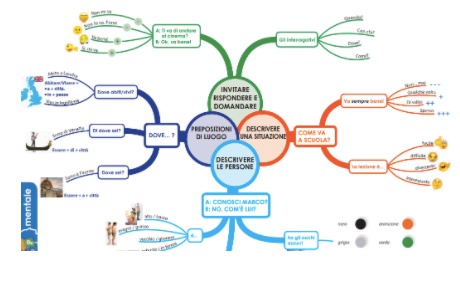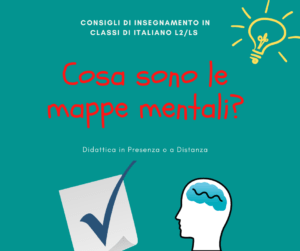One of the things I use a lot in my Italian L2 class, in presence but also online, are maps – mind and conceptual – to organize and optimize study and memorization in the different areas of students’ language journey. Let’s start with the fact that while both are logical-visual organizers of knowledge, there is a difference between a mind map and a concept map. Each responds to specific logics and objectives and are not interchangeable. In this article we will deal with mind maps.
What is a mind map?
According to the creator’s definition of mind maps, it is “a holistic, graphic and visual tool that can be applied to all cognitive functions, especially memory, creativity, learning and all forms of thinking.” (Buzan, 2010)
Created in the early 1970s by Tony Buzan, a cognitivist psychologist, mind maps are based on the concept that the human mind associates information in a radial, nonlinear way. The main concept is placed in the center, and from there a series of information and keywords, often also replaced by images, branch out from the general to the particular. Think about how file folders are organized in the computer: we go from a general Documents folder that, in turn, contains several subfolders with different topics. These contain even more detailed subfolders, all the way down to the files. So, the mind map is the visual expression of the human mind’s association of thoughts and concepts.

As can also be guessed from the proposed image, each concept embedded in a mind map can become the center of a further mind map; this is precisely because it is an infinitely extendable radial structure.
How to use mind maps during Italian foreign language class?
First, the use of this very effective tool in offering an overview of the knowledge being acquired is very useful for taking stock of the situation during reflection or at the end of a unit, particularly with regard to pragmatic and lexical competence. By visually summarizing the key words that have characterized the performance of the activities, it will be easier not only to memorize but also to re-employ what has been seen during the meetings.
I go even further: why not propose work on completing or constructing mind maps? The Web provides us with free and intuitive resources that we can share and have our students use in collaborative learning or even simply as a check on skills acquired. https://www. mindmeister.com/it
Online or in-presence, mind maps offer us the opportunity to significantly assist students (including those with DSA problems) during their journey and are a versatile and creative tool useful in making the learning environment active and therefore truly effective and motivating.
Simona Consolazione
